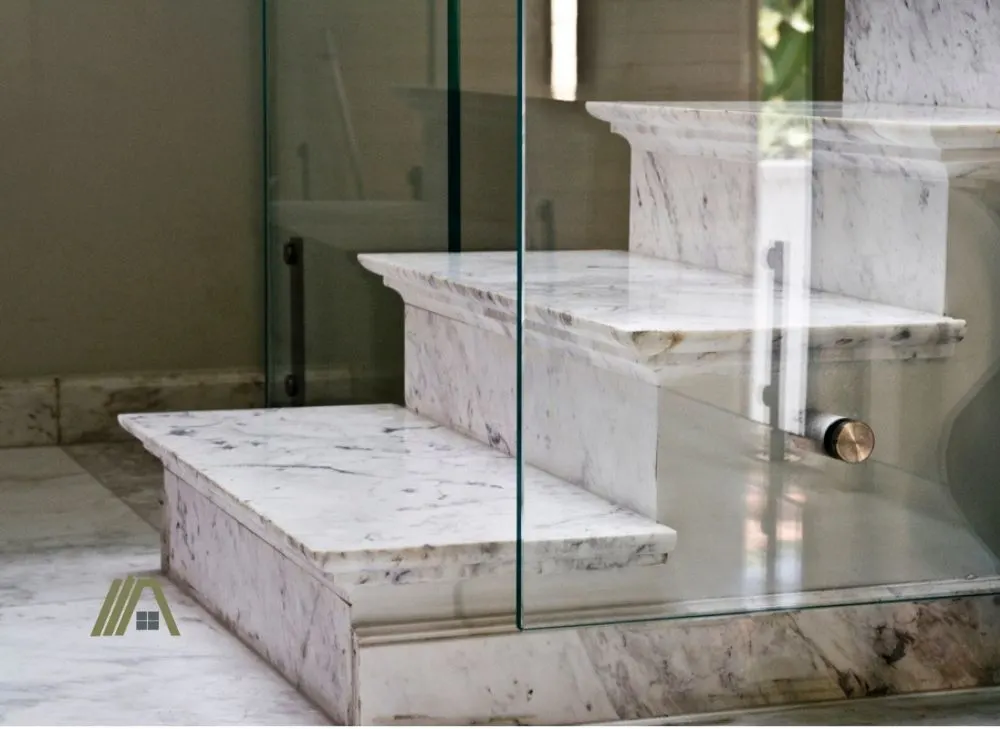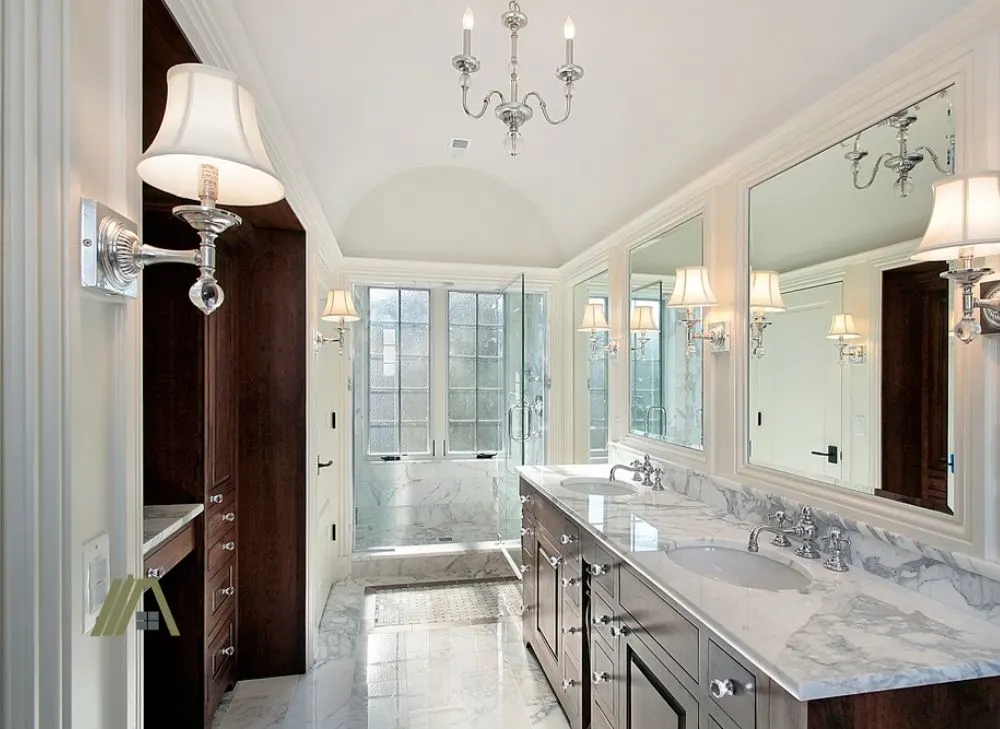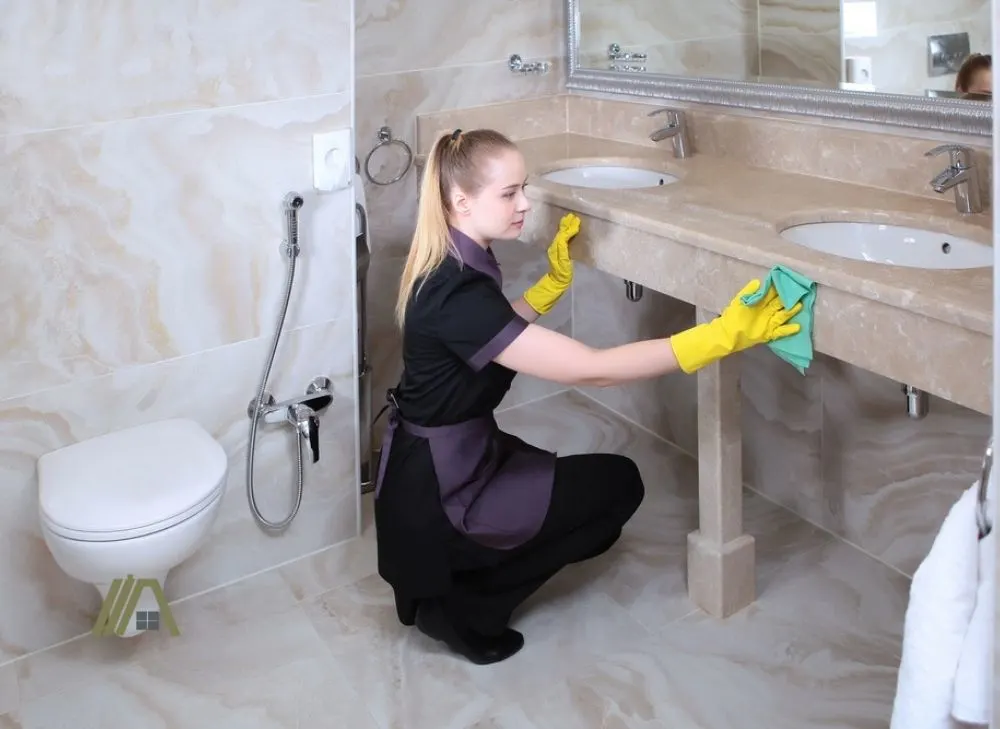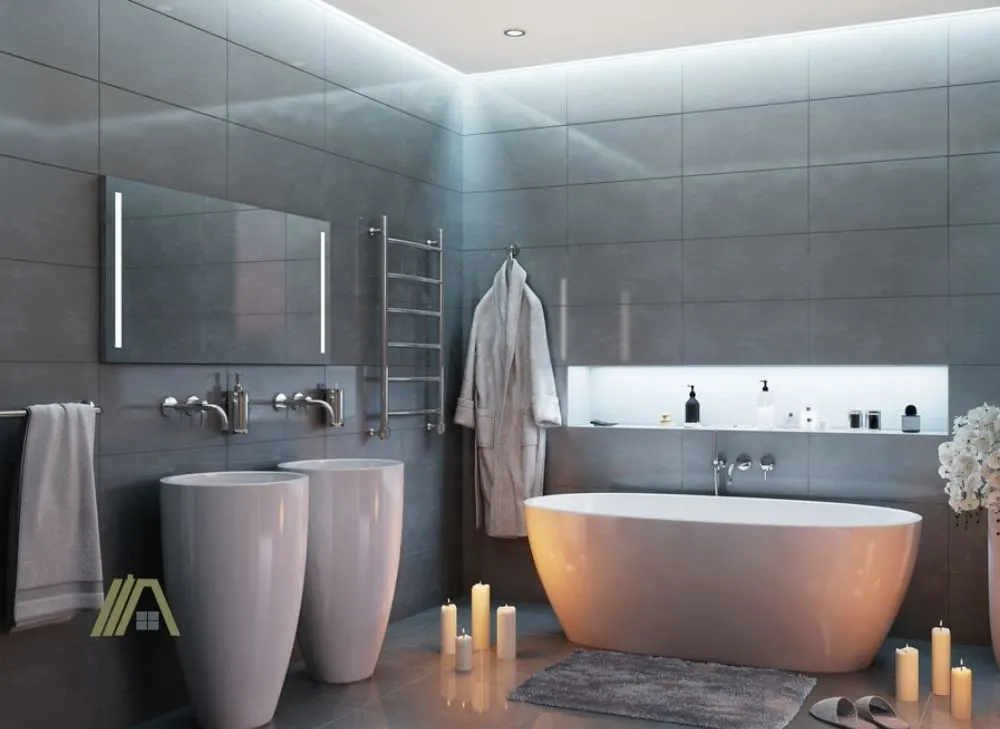Let’s face it, whenever you’re designing your home and want to add a little bit of a luxurious or elegant touch, marble floors definitely come to mind. Marble has been used for centuries and is very easy to clean (if you keep them well-sealed). However, it does have one characteristic that you have to consider when putting it on the floor: marble can be very slippery.
Because we know that if you have the option to install marble flooring, it will be very hard to give up that option, we have put together some tips to reduce the slipperiness through anti-slip treatments, cleaning habits, and anti-slip carpeting.

Honed marble is less slippery than polished marble. Whatever marble is used, slipperiness can be reduced by opting for smaller tiles, taking steps to keep the floor dry, using anti-slip treatments, clean the floor, using non-slip rugs/mats, and/or avoiding too much topical sealer.
Not All Marble Is the Same
Stone floors come in many different colors and finishes. Two of the more common finishes include a polished finish or a honed finish.
- Honed finishes are more natural where the stone has been sanded or ground down into a consistent surface, which creates more of a smooth matte finish on the stone.
- Polished stone is sanded down until the stone is naturally shiny. It is then coated with a protective coating, which gives it its shiny, smooth finish.
Honed marble floors are less slippery than polished marble as well as being more resistant to scratches. Polished marble is not without its advantages. Although more slippery, it stains far less easily and is easier to clean than honed marble.

Where to use each type of marble depends on its characteristics and the main purpose of a room or space in a home.
Choose the Right Type of Marble
Different spaces in a home are used differently and would make sense to use the right type of marble to best suit that space.
Due to its slippery nature, polished marble floors would not be the most suitable option for bathrooms. Any moisture on a smooth glossy surface spells disaster.
It would be best to use honed marble floors here. Yes, they are more likely to get stained with water (particularly if you cut corners when sealing the floor), but it is much safer as the matt finish prevents you from slipping.
It may also be best to use honed marble on stairs, especially if you have kids that run down the stairs in their socks on a winter’s evening or if you are walking down the stairs with shoes that have no rubber soles.
In such places, there may not be any moisture on the marble as you would in a bathroom, but if you slip you may roll down the stairs and break a bone or it could be fatal.
Polished marble would be best suited for living rooms and kitchens as there is less traffic in these areas and the marble is easy to clean here.
6 Tips to Make Marble Floor Less Slippery
1. Opt for Smaller Format Tiles
If you are placing polished marble tiles in a space, you may want to consider using smaller tiles, this may mitigate the risk of slipping. The smaller the tiles are the more spaces you will have between them. Grout fills these spaces to prevent the tiles from shifting and can also act as mini grip strips to make the marble floors less slippery.
It may be easier to lay larger tiles, but smaller tiles help prevent you from slipping on a surface area because it is inconsistent and interrupted by grout strips. Larger tiles provide a more consistent slippery surface area.
Smaller tiles, however, may not be as elegant and luxurious looking as larger tiles. Smaller tiles may make the room appear more cluttered and smaller. Furthermore, lining up the designs is difficult, and the smaller the tile, the more designs you will have to match up.
2. Keep the Marble Dry
Polished marble floors are slippery as is. Other factors, like moisture build-up, add to the slippery factor. This is especially important in bathrooms, showers, and sometimes kitchens.

When you have had that long relaxing shower, condensed water creates dangerous pools, which you can slip on later. You will need to ensure you have excellent ventilation in place. I highly recommend using an exhaust fan, but if you can’t, here are 12 Tips to Keep Bathroom Dry Without a Fan.
You can always wipe the floor too, but be careful because even if you wipe the floor, some drying cloths don’t make the tile completely dry and the tiles will still have some moisture. You need to also be careful when you walk on tiles with wet feet, make sure they are dry too.
3. Use Anti-Slip Treatments
Luckily, there are anti-slip treatments that you can use to coat your tiles without affecting the marble aesthetic. This can be a simple DIY job or you can hire a professional.
If you decide to apply the anti-slip treatment (amazon link) yourself, you are going to need:
- a mop
- 2 buckets
- a soft-bristle broom
- Fill both buckets with clean water. One bucket will be mixed with the Anti-slip treatment of choice (mixing measurements from the manufacturer will need to be followed here).
- Mark off areas that are not to be treated and thoroughly clean the area.
- Mop the area with clean water and apply your anti-slip mixture over the wet surface using your broom. Apply in a North-South and East-West movement to cover the entire surface area.
- Make sure the floor is wet with clean water every time, do not apply the treatment on dry surfaces. For a more thorough explanation you can watch the video below:
Be careful to not use just any treatment as marble is a porous stone and can easily absorb liquids. Some solutions that may damage marble floors are those that are acidic, solutions that are meant for granite tops only, and bleach.
4. Clean the Floor Properly
If you have a busy household, you will know that it is almost impossible to keep clean, especially your floors in areas with heavy traffic.
You and your guests may constantly bring dust and sand (especially if you live near the beach) into your home and may have grease build up on your kitchen floors from cooking up those feasts as you go through your Gordon Ramsey phase.

All these factors add up and make your marble floors more slippery. Luckily, marble floors are surprisingly easy to clean, especially if they are polished.
- Use a dust mop (amazon link) to mop away sand and dust to prevent them from scratching the floors.
- Add a few drops of the cleaner (amazon link) with some water and wipe the floor with a wet mop. Make sure there isn’t too much water as water puddles may stain the marble if left too long.
- Once you have rinsed your floors, dry them with a soft microfibre cloth.
Remember to not use any acidic solutions on your marble floors. You can kill two birds with one stone by purchasing cleaning products that contain anti-slip properties.
5. Use Carpets and Mats
It would seem like a waste to have to buy carpets or mats that cover up the beauty of the stone, which is pretty much the main reason why people spend hundreds of dollars on this type of flooring.

However, it may be worthwhile to place a non-slip mat (amazon link) in the bathroom at the entrance of your shower or bathtub as it will be extremely slippery coming out of either.
Placing a beautiful carpet with a non-slip backing in your living room or hallway may add a little extra pazazz to your interior all the while making your floors less slippery. If you have marble stairs you can use anti-slip tape that is placed on the surface of each stair. Some tapes are even transparent.
6. Don’t Use Too Much Topical Sealer
Topical sealers are coatings that bond to the material surface for protection from stains and other physical damage. Topical sealers can be applied over penetrating sealers too.
If you apply too many coats of topical sealer, however, it may cause your marble floors to become more slippery when wet. You also need to take the type of topical sealer into consideration as not all sealers are well suited for marble floors.
For example, polyurethane sealers are mainly used as wood sealers, however, some manufacturers suggest using them on marble surfaces, which can leave an artificial glaze on the stone and damage, making it even more slippery.
You may want to rather consider Fluoropolymer sealers, which have a long-lasting factor.
Sources
https://www.bcstone.com/blog/honed-vs-polished-marble/
https://www.noslipstrip.com/products/no-slip-tapes
https://store.countertopspecialty.com/SCP-ANTI-SLIP-Floor-Tile-Cleaner-gal-p203.html
https://www.stonetooling.com/Sealer-Buying-Guide-Topical-Sealers-s/680.htm
https://www.fullerstonecare.com/penetrating-sealers-versus-topical-coating-sealers/ https://sefastone.com/blogs/s/marble-sealer-types-and-how-to-use-them
